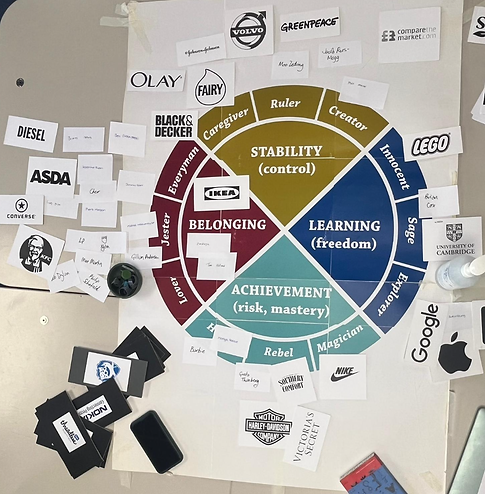Week Three_Naming Protocols & Archetypes
Company Naming Protocols
In his TED talk, Jonathan Bell talks about the 7 categories of company names:
-
Eponymous - Named after someone, eg. Disney, Stella McCartney, Tesla
-
Descriptive - Tells you what they do, eg. Poundland, British Airways
-
Acronymic - Shorthand for descriptive names, could be strategic if full name is unhelpful eg. KFC, HSBC, JVC
-
Suggestive Suggests attributes or benefits, falls into 3 categories
(Real eg. Uber, Slack / Composite eg. Facebook, Ray-ban / Invented eg.Kleenex, Pintrest)
-
Associative - Reflects imagery and meaning back to the brand, eg. Amazon, Red Bull
-
Non-English - Words that are not English, eg. Samsung (means 3 stars in Korean), Lego (means Pay well in Danish) [*I feel these should come under descriptive]
-
Abstract - Made up but mean nothing eg. Rolex, Kodak
Bell also recommends that you check if the name is already in use before taking to market and he also suggests checking that it doesn't have negative meaning or connotation to different audiences.
I felt that these categories, while potentially a source of inspiration if struggling to produce a name, are somewhat arbitrary due to the overlap of categories and a little demeaning to categorise all Non-English words as one, I appreciate this maybe how the common market works but doesn't feel very progressive.

Universal Archetypes - Flux
fluxbranding.com
Archetypes
archetype
/ˈɑːkɪtʌɪp/
noun
noun: archetype; plural noun: archetypes
1. a very typical example of a certain person or thing.
"he was the archetype of the old-style football club chairman"
2. PSYCHOANALYSIS (in Jungian theory)
a primitive mental image inherited from the earliest human ancestors, and supposed to be present in the collective unconscious.
3. a recurrent symbol or motif in literature, art, or mythology.
"mythological archetypes of good and evil"
Archetypes are the blueprint for universally understood characters. These allow us to quickly understand and categorise the essence of someone of something, allowing us to identify with or aspire to this entity.
There are a variety of Brand Archetype Wheels, but there are all essentially based on the same ideas and boiled down into the 4 underpinning motivations; Stability, Belonging, Learning and Achievement.


We had a go as a group at allocating first celebrities, then brands to the 12 Archetype characters that stem from the 4 motivations. Generally this was quite straightforward with the people, a little more challenging with some of the brands, but an interesting exercise in mindset shift about brand identity.
Leading on from Archetypes and motivation, Simon Sinek talks about a 'Golden Circle' when tapping in to motivation and making a brand connection. Successful companies like Apple talk about their why before sharing the how and then what.

The reason Sinek attributes to this method being successful it that the why, or the purpose talks about emotional motivators and that taps in to our limbic brain.
According to WebMD "The primary limbic system function is to process and regulate emotion and memory while also dealing with sexual stimulation and learning. Behavior, motivation, long-term memory, and our sense of smell also relate to the limbic system and its sphere of influence." This is our instincts.
The what deals with statements of fact, appealing to our neocortex, the newer part of the brain responsible for thinking and reason, we may well hear all the reasons as to why a product might be good, but we need that 'gut' pull to spend £1200 on a new iPhone that does essentially the same thing as something half the price.